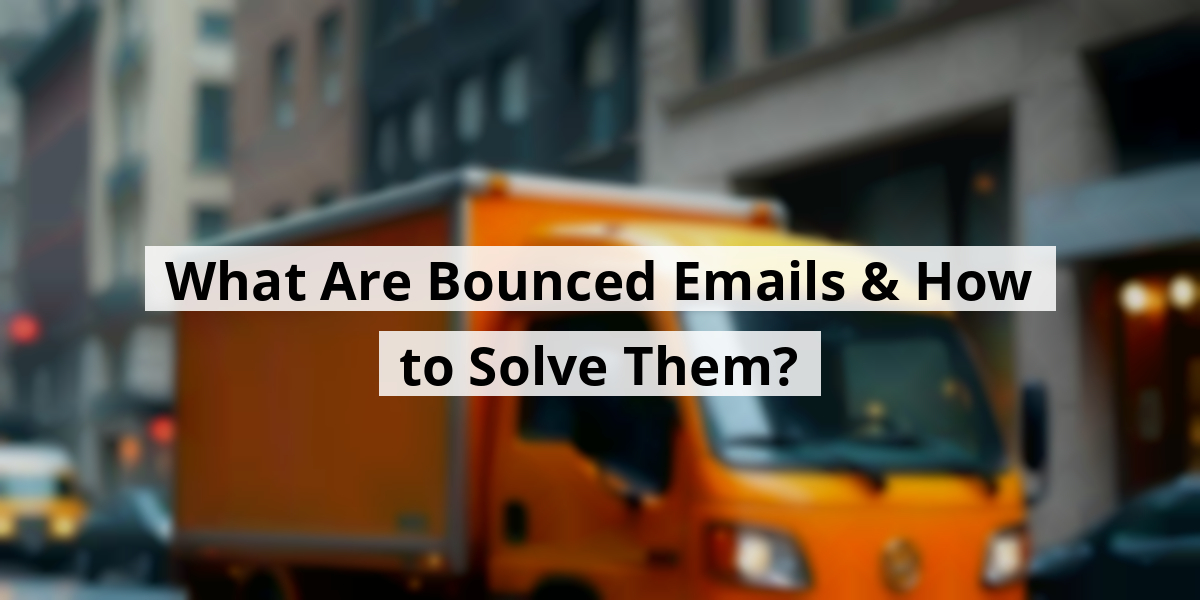 LIMITED SPOTS
All plans are 30% OFF for the first month! with the code WELCOME303
LIMITED SPOTS
All plans are 30% OFF for the first month! with the code WELCOME303

 LIMITED SPOTS
All plans are 30% OFF for the first month! with the code WELCOME303
LIMITED SPOTS
All plans are 30% OFF for the first month! with the code WELCOME303


Now we are going to talk about something that can make or break our communication efforts—bounced emails. Getting one can feel like a punch to the gut, right? Let’s explore what they are and how we can handle them like pros.
A bounced email is basically a polite way for a mail server to say, “Sorry, I can’t deliver this.” Much like trying to send a telegram to a friend whose address is now a taco stand (true story!), it just doesn’t work. Sometimes it’s just that the recipient’s inbox is packed tighter than a suitcase for a month-long vacation. But other times, we’re talking about more serious issues, like a typo in the email address: nobody likes a misspelled name, after all.
We’ve all been there. Remember that time someone misspelled your name on a birthday cake? Yeah, awkward. So, it’s crucial for us to distinguish between two types of bounces. A hard bounce means the email address is either non-existent or invalid. Think of it as shouting into a void. A soft bounce, on the other hand, suggests temporary issues, like a full inbox or server problems. It’s like your email went to a party, but the bouncer wouldn’t let it in because it didn’t have a proper ID. Here's a quick rundown:
Understanding these can help us act swiftly, kind of like knowing when to pull a pair of handcuffs off and when to keep them on during a game of charades. For instance, if we’re consistently getting hard bounces, it’s a major red flag—and time to fix that email list faster than a coffee break.
Using strategies like double opt-in is like putting a safety net beneath us. It ensures that we only get addresses that really want to hear from us. Nothing feels quite as satisfying as watching our email campaigns soar into inboxes where they belong. Let’s be honest—no one wants to see their hard work end up in the digital equivalent of a trash can, right? In this constantly evolving communication landscape, being proactive gets us ahead. So, next time someone mentions a bounced email, we can smile, give a nod, and dive headfirst into the solutions instead of sulking about the issue. Happy emailing!
Now we are going to talk about different types of bounces in email marketing. Think of them as the email equivalent of a “return to sender” stamp, but with a bit more flair.


Soft bounces are like temporary roadblocks on the email highway.
You know, when you hit a smooth stretch, and suddenly there it is—traffic! Maybe the recipient's mailbox is overflowing like your laundry basket after a long week, or the server is taking a coffee break.
Don't freak out just yet; soft bounces aren’t a sign that you're being ghosted. They're often just a hiccup.
The remedy? Simple: a spoonful of patience and a sprinkle of attention to those bounce messages can help figure out the next move.
Just like waiting for your favorite pizza to arrive, resending that email after a short wait could do the trick.
But if you notice soft bounces popping up more often than your neighbor's loud music, it might be time to check on the content or chat with the recipient’s email provider.
Now, hard bounces are a whole different beast—they're the truly uninvited guests at your email party.
These guys show up when your email is addressed to a non-existent email or if the domain has taken a permanent vacation.
It's essential to verify your email addresses, spot bounce notifications, and keep your subscriber list in tip-top shape.
When dealing with hard bounces, immediate action is key. Think of it like finding out you’ve left the oven on—don’t just stand there!
Clean house by removing those invalid addresses pronto. Using email verification tools or a double opt-in process can greatly help in keeping hard bounces at bay.
By acknowledging that hard bounces happen and acting quickly, we can keep those email deliverability rates up and our inboxes happy!
Now we are going to talk about something that often makes email marketers scratch their heads: bounce codes. These little nuggets tell us when an email has done the digital equivalent of slamming a door in our faces.

Bounce codes are like the hints you get from a friend after a bad first date—they help explain why your email didn't make it to the recipient's inbox. They can save you from the headache of sending emails into the void.
Imagine sending an email and eagerly waiting for a response, only to get a bounce back with a code. It's like ordering a pizza and getting a salad instead. Let's explore the fascinating world of bounce codes together, shall we?
1. SMTP Error Codes: These three-digit codes are the bread and butter of bounce messages. They typically follow a format like "550." This little guy usually means, "Oops, we can’t find that email address!" It’s like trying to find your car keys after deciding to move houses and realizing they must be under a pile of boxes.
2. Extended Bounce Codes: Think of these as the deluxe version of SMTP codes. They carry extra digits or characters, providing a deeper dive into why your email didn’t land. A classic example is “5.1.1,” which proudly announces that your recipient’s address doesn’t exist anymore. Yikes!
5xx: Permanent failures, like:
4xx: Temporary failures, such as:
Reading bounce codes is a bit like reading the fine print on a contract—you gotta pay attention. Here’s how to decode and respond:
| Bounce Code | Type | Meaning |
|---|---|---|
| 550 | Permanant | User not found |
| 552 | Permanant | Exceeded storage allocation |
| 421 | Temporary | Service not available |
| 450 | Temporary | Mailbox unavailable |
Now we are going to talk about some effective strategies to keep those pesky bounce rates in check.
Bounces are like the unwanted guest at a party—no one wants them around, and they can really ruin the mood!
An email list full of outdated addresses is like a fridge filled with expired milk. Regularly rolling up your sleeves to clean and update your lists can save you a lot of heartache.
We’ve all received those “failed to deliver” emails, right? By using email verification tools to keep things tidy and by ditching the addresses that lead nowhere, we can significantly reduce those cringe-worthy moments.
Implementing a double opt-in process is like having your friend text you before showing up at your door. It’s a reassurance that the person really wants to be there!
This method sends a friendly email nudging new subscribers to verify their interest. If they don’t? Well, they don’t make it onto your list, which means your audience remains genuinely interested. A win-win!
Investigating the reasons behind those hard and soft bounces can feel like solving a mystery. Are they bad addresses? Are they just playing hard to get?
Digging into bounce codes and responses can help us identify whether it’s time for an intervention or just a little TLC with our email strategy.
Let’s be honest: nobody likes being bombarded with emails they didn’t ask for.
Making it easy for recipients to manage their preferences—even opting out—isn’t just good manners; it’s also a great way to build trust. And hey, nobody likes a spam report on their record!
A simple unsubscribe link does wonders to keep that frustration at bay. After all, a happy subscriber is much less likely to bounce!
Following these tips can help keep that bounce rate low, allowing for smoother, more engaging email campaigns! Just remember: it’s all about keeping it personal and relevant—the way we would want it if we were on the receiving end!
Now we are going to explore some smart tips for keeping bounce rates low in our email marketing adventures. Honestly, managing emails can feel like trying to herd cats sometimes, but with a few tricks, we can make it less chaotic!


Email marketing isn’t just a matter of sending out notes and hoping for the best. Nope! It’s more like cooking a five-course meal: it takes time, commitment, and trial and error—especially if your idea of cooking is tossing a frozen pizza in the oven. So, let’s dive into some practical advice for becoming email marketing whizzes.
Ever watch someone try to run a marathon without proper shoes? That’s kind of what sending untested emails is like! Testing your emails on different platforms and devices can really ensure they look sharp and are less likely to trigger spam complaints. We’ve all been there, hitting 'send' and then realizing our perfectly crafted message looks like a toddler’s finger painting on some devices. Avoid that panic!
Think about it: why would anyone stick around for an email if it’s all fluff? Crafting content that makes your audience go, “Wow, I can’t believe this is free!” not only boosts engagement but also slashes those “unsubscribe” rates. It’s like making a perfect cup of coffee that’s so good, they wouldn’t dare throw it away!
Choosing the right ESP is like picking the right gym—your chances of success greatly improve! A good provider means that your emails will be cared for properly, which ultimately enhances email deliverability and helps keep those bounce rates from flying off the charts.
We all have that friend who can’t help but share their latest mishap. This can actually be beneficial! Observing the wins and losses of others in email marketing can give us a fantastic insight into what works. Learning from their blunders can help us dodge the pitfalls ourselves!
Imagine building a great reputation only to watch it crumble because you didn’t monitor bounce messages. Ouch! Keeping tabs on your sender standing and proactively adjusting your authentication settings can really save face. Remember, a bounced email can knock a big dent in your credibility.
Investing in smart tools isn’t just recommended; it’s vital! Proper tools can be your trusty sidekicks in the quest to manage deliverability and keep bounce rates low. Whether you need to validate email addresses or manage soft bounces, having the right tech can make life a breeze!
Finally, let’s sprinkle in some personalization. Sending mass emails is like showing up at a party without knowing anyone—awkward! If we learn how to send emails to multiple recipients while keeping each one feeling special, it drastically decreases the chances of our messages landing in spam folders.
Email marketing may not be a walk in the park, but with these strategies in hand, we can certainly make our way through the jungle much easier!
Now we are going to talk about an exciting solution that can spice up your email strategy. If you’ve ever sent out an email, only for it to disappear into the digital abyss, you know the struggles of achieving solid email deliverability. It’s like sending an invitation to a party, but no one shows up—awkward, right?
Enter Warmup Inbox. Think of it as your email’s personal trainer—getting it fit and ready to run those long races without losing steam.
Remember when we sent that important pitch and half of our recipients thought they were in a witness protection program? That's what can happen if our email gets flagged as spam. So, how can we avoid this embarrassing scenario?
By gradually sending out emails to reliable addresses, we help our domain's reputation grow, kind of like watching your garden bloom after a week of rain. And just like plants need water, our emails need a little warming-up to make sure they don’t land in the digital junkyard.
Let’s face it, we all want our emails to feel like VIP guests, not wallflowers at the party. Because who likes rejection, right?
So, next time you’re wondering what’s going wrong with your email delivery, consider giving Warmup Inbox a go. It’s like putting your email through a boot camp—only less sweat and more tech magic!
Want to give it a shot? How about signing up for a free trial and letting those emails strut their stuff? It’s about time our email marched straight into the inbox like it owns the place, don’t you think?
Now we are going to talk about how to nail those email marketing strategies like a pro.

Picture this: you craft an email that sparkles brighter than a diamond, but when you hit send, it’s like tossing a message in a bottle into the ocean. What happened? It flopped! We all know that email deliverability can make or break a campaign. It's like a first date; if you make a bad impression, it’s hard to recover.
To keep our email strategy afloat, we have to invest in the right tools. Ignoring hard and soft bounces is like ignoring a leaky faucet; it will only get worse! Understanding these terms is crucial:
In our quest to combat those pesky bounces, let’s keep it simple. Approaching our campaigns with a blend of monitoring, adaptability, and savvy tool usage is key. For instance, have we ever tried tools like Mailgun? It's handy for tracking email performance in real-time, which helps us adjust our strategies on the fly.
| Strategy | Description |
|---|---|
| Regular List Clean-up | Removing invalid addresses keeps bounce rates down. |
| Engagement Tracking | Monitor who opens, clicks, or even ignores your emails. |
| A/B Testing | Experimenting with different subject lines or content to see what works. |
| Personalization | Addressing your audience by name can turn a cold lead warm! |
When we implement these elements, email marketing becomes much less of a headache and a whole lot more of a joyride. It fosters a relationship with the audience, turning those little inbox moments into meaningful conversations—which is exactly how we want to elevate our marketing strategy!
Now we are going to talk about understanding email bounces, those pesky little hurdles that can trip up any email marketing campaign. We've all felt the sting of an unopened email, right? Let’s break it down into bite-sized pieces, with a sprinkle of humor and a dash of insight.


Ah, email bounces. They’re like the party crashers of email marketing. Picture this: you’ve crafted a dazzling message, and it crickets. That’s a bounce in action. These bad boys can hurt our sender reputation and drop our delivery rates faster than a cat avoiding water. In essence, fewer inboxes mean fewer eyes on our content, which is not what we want!
So, let’s break it down further. A hard bounce is as stubborn as a toddler refusing broccoli—an email address that doesn’t exist or has gone MIA. On the flip side, there’s the soft bounce. Think of it as your friend who repeatedly hits snooze on their alarm. They’re still around but can’t handle your email at this moment. A full inbox or server issues are classic examples.
A bounce message is like a text from your friend saying they're running late. It gives us the scoop on why our email didn’t make it. These messages may come with codes, which can sound like a secret language. An SMTP error message might pop up, letting us know exactly where things went wrong. It’s like having a personal assistant telling us what needs fixing!
Reducing bounce rates requires us to roll up our sleeves and get a little crafty. Here are some quick tips to help us avoid sending emails into the black hole:
Just like we have codes for pizza delivery (who knew?), email bounce codes tell us why our emails didn’t reach their destination. These little snippets can point to invalid email addresses or, even worse, those pesky server issues. Understanding them means we can fix our errors and get back on track—like repairing a flat tire on the highway!